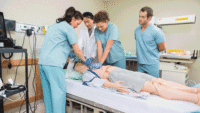Today’s bedside nurses are inundated with computerized documentation, patient-care coordination, and task lists. Their responsibilities leave them little time to engage in unit-based decision making.
On our 30-bed observation unit at Carolinas Medical Center (CMC, part of Carolinas HealthCare System) in Charlotte, North Carolina, we faced the same challenges as many: How can we increase team members’ participation and engagement in unit-based shared governance? How can we hold staff accountable for their participation? How can we include multidisciplinary team members in this engagement? In this article, we share strategies that have proven effective in enhancing engagement and active participation in our unit’s shared governance council.
Shared governance: A Magnet® principle
CMC is a Magnet-designated hospital, and shared governance is an important Magnet principle. Shared governance promotes joint accountability and responsibility for making decisions that affect nursing practice. When frontline staff members are empowered to make decisions, they’re more likely to take ownership of their practice, both at and away from the bedside.
On our unit, participating in shared governance is the nurse’s professional responsibility. Our nursing department’s organizational structure and professional practice model support shared governance. The current model was created by a team of bedside nurses representing every CMC area where nursing is practiced. The shared governance ideal was strategically placed on the professional practice model as one of the driving forces in meeting our overriding goal of providing excellent care.
To increase unit-based shared governance participation and empowerment, we use four strategies:
- emphasizing accountability
- allowing teleconferencing
- promoting multidisciplinary involvement
- staying on task.
Emphasizing accountability
The nurse’s job description includes patient-care responsibilities but rarely mentions professional ones. At CMC, the nurse’s responsibilities include participation in shared governance, evidence-based practice and research, and advancement in formal education.
On our observation unit, accountability begins with the interview process. During a job applicant’s initial interview, the manager and peer-interview team establish expectations that the nurse will attend unit-based shared governance meetings. We tell applicants that being involved in shared decision-making affecting work done on the unit is the individual’s responsibility and obligation to the peer team.
Shared governance meetings are led entirely by elected unit-based council co-chairs; the unit manager attends only the last 15 minutes to address issues and concerns. This practice promotes openness among teammates and puts accountability for the work in the hands of frontline staff. Team members on the observation unit are held accountable for unit-based shared governance participation and attendance standards in annual performance appraisals.
Allowing teleconferencing
Teleconferencing permits all team members to attend meetings. In a world that’s becoming more reliant on technology for communication, teleconferencing promotes staff participation in unit-based shared governance. It’s especially helpful for nurses who work 12-hour shifts, nights, or weekends.
Unit-based shared governance meetings are held the fourth Monday of every month. Historically, they were scheduled for 10:00 am, after journal club. But night-shift team members requested we reschedule them for 8:30 am to help them avoid sleep disturbances and increase their participation. Team members have the option to attend either in person or on the phone and are compensated for their time.
Promoting multidisciplinary involvement
At CMC, nursing has a mature shared governance structure, and the concept has trickled over to other departments. A multidisciplinary team member usually attends our meetings. Because of the precedent we’ve set, multidisciplinary team members view this venue as the ideal setting to discuss practice changes and present staff education sessions, taking advantage of the numerous staff members from all shifts who are present. When an issue or concern about a particular department arises on the unit, we invite an interdisciplinary team member to attend the next unit-based shared governance meeting to discuss, clarify, and resolve the issue. Members of the dietary, bed management, interventional radiology, physical therapy, human resources, and case management departments have attended our meetings. Such collaboration encourages teamwork, helps build healthy relationships, and promotes alignment of high-quality patient-care goals.
Staying on task
Time-wasting is never on the agenda. Our meeting format assigns all agenda items a specific order and time slot. Participants must adhere strictly to the time allotted for each item.
To kick off the meeting, a guest speaker typically presents an educational offering on a new drug or a policy update. Team members are required to present a yearly staff education session, which is allotted a 5- to 10-minute slot. Presenting staff education offerings this way has several benefits: It offers a venue where many nurses are present and attentive, and it helps nurses develop professional public-speaking skills.
To help maintain the timeline during the meeting, council co-chairs collect updates from unit representatives on hospital committees before the meeting. This helps them present the new information in a fluid and efficient manner. After committee updates, the council discusses unit-specific updates, which may include such items as the new bedside reporting initiative, the engagement survey action plan, or growth opportunities identified from rounding with patients and staff. At this point, the meeting becomes a working one where new ideas and solutions are developed. CARE (Carolinas Automated Reporting Environment) events also are discussed at this time. (See Understanding the CARE system.)
At the end of the meeting, attendees have time with the manager or a management team member to raise concerns or issues discussed in the meeting. For example, if questions arose about acquiring equipment or supplies to address an action plan, this is when they discuss them with the manager.
Healthcare technician-led unit-based council
After seeing the success of the nurses’ unit-based shared governance structure, CMC healthcare technicians (HCTs) decided to start their own shared governance council on the unit. HCTs include certified nursing assistants and unit secretaries. The HCT shared governance council is led by two HCTs and a staff nurse liaison. Meetings are held monthly; teleconferencing is available for those who can’t attend in person.
This council has increased HCTs’ accountability and initiative in the work they perform. When a pertinent issue arises, it’s added to the meeting agenda for discussion. The HCT leader attends the nurse unit-based shared governance meeting to represent HCT peers and address identified problems.
Outcome measures
The observation unit has about 45 RNs and 20 HCTs. RN council attendance participation was 32% in 2011 and 32% in 2012. In 2013, it increased to 38% and in 2014, to 52%.
Remarkably, HCT participation has skyrocketed since creation of the HCT shared governance council in 2012. It was 51% in 2012, 67% in 2013, and 63% in 2014 (with the small decrease possibly caused by a slight turnover in HCT staff).
The observation unit has maintained the highest ranking on the CMC engagement survey for the past 4 years (2011 to 2014). In the most recent survey, we received our highest scores to date. When survey results were broken down into RNs and HCTs, HCTs had a larger increase than RNs in their commitment indicator from 2012 to 2013. This demonstrates a positive relationship between participation in the HCT-led unit council and their engagement scores.
We believe these successes result directly from the strategies our department uses to increase empowerment and participation of bedside nurses in decision-making affecting their work. Accountability, teleconferencing options, multidisciplinary involvement, and a focused agenda have proven effective in promoting growth and development of our unit-based shared governance structure among both RNs and HCTs on the observation unit team.
Selected references
Barden AM, Griffin MT, Donahue M, Fitzpatrick JJ. Shared governance and empowerment in registered nurses working in a hospital setting. Nurs Adm Q. 2011;35(3):212-8.
Stonehouse D. Support workers: key members of the multidisciplinary team. Brit J Healthcare Assist. 2013;7(10):512-4.
Sarah Nantz is nurse manager of the observation unit at Carolinas HealthCare System’s Carolinas Medical Center in Charlotte, North Carolina.


















5 Comments.
Thank you for sharing this article.
it helps me to present in a professional practice model awareness session.
This information assists in this existing issue in my unit based council meeting in the hospital I worked. I am a co-chair and will implement these suggested strategies for participation enhancement.
This information assists in this existing issue in my unit based council meeting in the hospital I worked. I am a co-chair and will implement these suggested strategies for participation enhancement.
This is a great article. I am currently the co-chair on our unit based council and was needing guidance on how to increase our participation. This has given me some good ideas. Thanks.
T. Taylor, RN
Sarah,
Thank you for sharing this article, it is exactly what I was looking for to start a unit based shared governance in our small critical access hospital!
Jen Klausmeier, MSN, MA